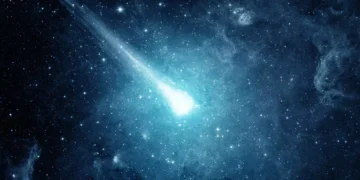Nothing captures the imagination of skywatchers quite like the sudden appearance of a new comet, and Comet C/2025 F2 SWAN is no exception. Seemingly out of nowhere, this cosmic traveler has emerged into view in the morning sky, and while its visit may be brief, it promises a short-lived spectacle for those willing to rise early and look east.
A Chance Discovery Thanks to Vigilant Eyes and Space Tech
Comet C/2025 F2 SWAN was first spotted by eagle-eyed observers such as Vladimir Bezugly, Michael Mattiazzo, and Robert Matson, who noticed a moving object in the SWAN instrument’s field of view from March 22 to 28. SWAN is designed to detect ultraviolet emissions from hydrogen, a trait that makes it ideal for catching sungrazing and inbound comets.
According to Universe Today and SciTechDaily, the comet initially shone at +11th magnitude, but by early April had undergone a brightness outburst, reaching +9th magnitude. This leap in brightness was enough to alert astronomers worldwide, prompting rapid observation campaigns to track the comet as it moved across the sky.
This isn’t the first time SWAN has contributed to comet discovery; this marks the 15th comet associated with the instrument, showcasing the ongoing importance of combining professional instruments with community-driven vigilance.
A Green Glow and a Spiky Tail: What Makes Comet SWAN Unique
Now officially designated C/2025 F2 SWAN, the comet is currently observable in the constellation Pegasus, near the bright star Alpheratz (Alpha Andromedae). Reports from observers describe the comet as a greenish fuzzball, a color caused by the presence of cyanogen and diatomic carbon gases that glow under solar radiation.
As of April 9th, it was estimated to be around +8 magnitude, with projections suggesting it could reach as bright as +4 magnitude—potentially visible to the naked eye in dark skies. It has already been captured on camera by amateur astronomers using tools like the Dwarf3 smartscope, showing faint tails and a growing coma.
Its trajectory and chemistry give it the potential to be the best binocular comet of the spring, if not the year—though its appearance will be fleeting.
Catch It Before It’s Gone: Visibility and Path
One of the most exciting (and challenging) aspects of observing Comet SWAN is its rapid movement and brief visibility window. From April 10 to 20, it will appear low on the eastern horizon just before dawn, best seen about an hour before sunrise from the Northern Hemisphere.
On April 12–13, it passes less than a degree from Alpheratz, offering an excellent target for amateur photographers and telescope owners. Unfortunately, the comet’s position will soon bring it closer to the Sun’s glare, making it increasingly difficult to observe.
After perihelion on May 1—when the comet will be just 0.33 AU (about 50 million kilometers) from the Sun—it will shift into the evening sky, but this appearance will be even more brief and low in the sky, particularly for northern observers. Its path will carry it through Taurus, Orion, and into Eridanus, where it will fade as it exits the inner solar system.
The Science Behind the Surprise
Comets like SWAN often come from the Oort Cloud, a distant, icy shell surrounding the solar system. On long, elliptical orbits, these objects are occasionally nudged inward by gravitational interactions. According to early estimates, SWAN follows a 1.3 million-year orbit, meaning this is likely its first and last visit to the inner solar system.
Because it approached from the direction of the Sun, it evaded earlier detection—until it brightened in late March. The sudden outburst seen in early April could be a result of fresh volatile materials being exposed to sunlight as the comet heats up, a phenomenon often seen in dynamically new comets.
What to Expect at Its Brightest
If all goes well, Comet C/2025 F2 SWAN could reach +4 magnitude near perihelion—on par with some of the better comets seen in recent years like NEOWISE (2020). However, comets are notoriously unpredictable: some fizzle, others flare.
Factors like its distance from Earth, angle to the Sun, and the strength of its outgassing will determine how bright and visible it ultimately becomes. Even a modest outburst could make it spectacular for just a few mornings.
Your best chance to catch it? Look low in the east-northeast sky before dawn with binoculars or a wide-field telescope. Even if you can’t see it with the naked eye, photography reveals much more.
Conclusion: Look Up While You Can
Comet C/2025 F2 SWAN may not rival the great comets of the past, but it’s a welcome surprise—a celestial guest bringing a touch of cosmic magic to our morning skies. Its brief appearance reminds us that, despite all our predictions, the universe still holds the power to surprise us.
This is a comet with a story: born in the outer darkness, discovered through shared curiosity, and burning brightly (if briefly) as it swings by the Sun. For skywatchers, it’s a reason to rise early, to look east, and to reconnect with the rhythms of the universe.



















